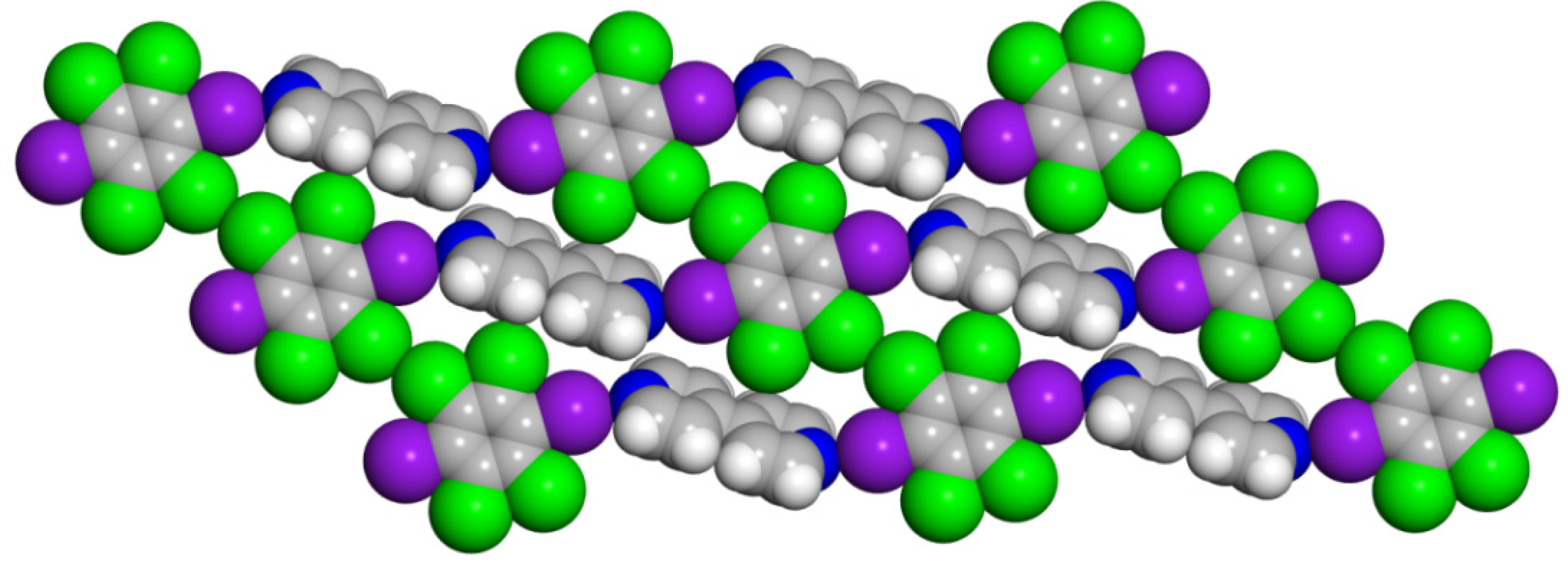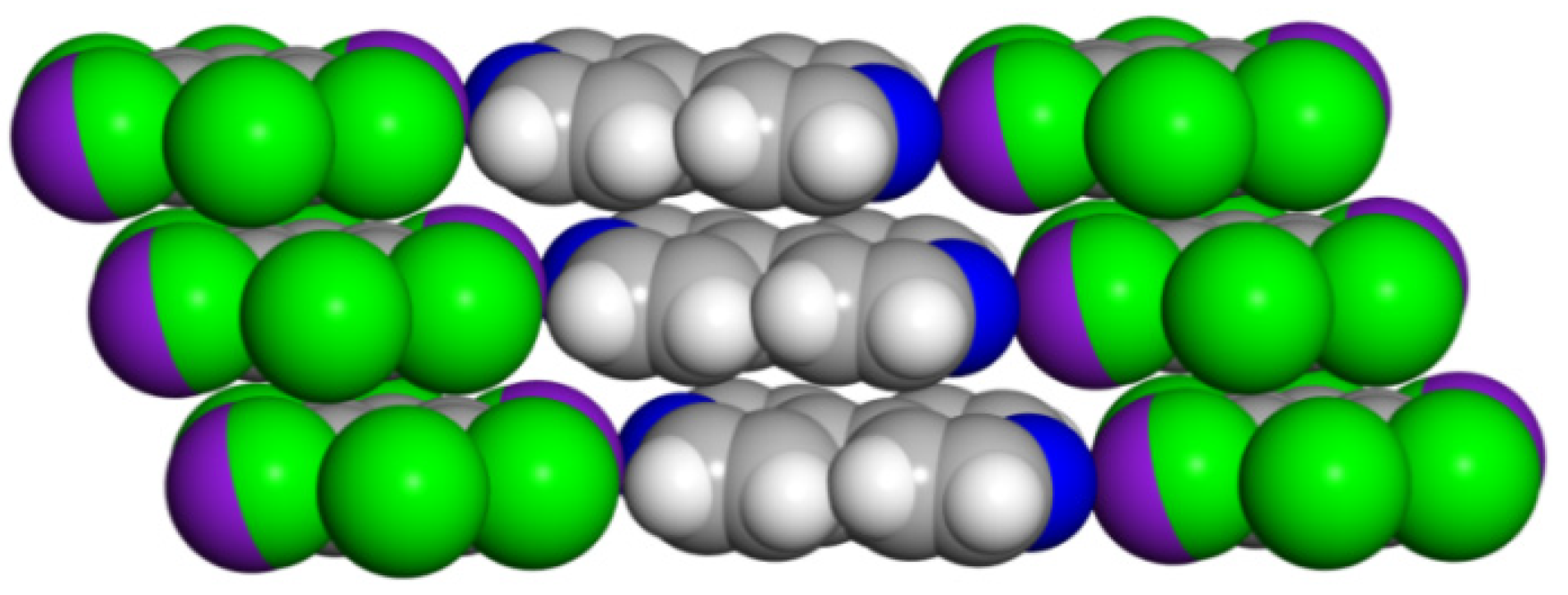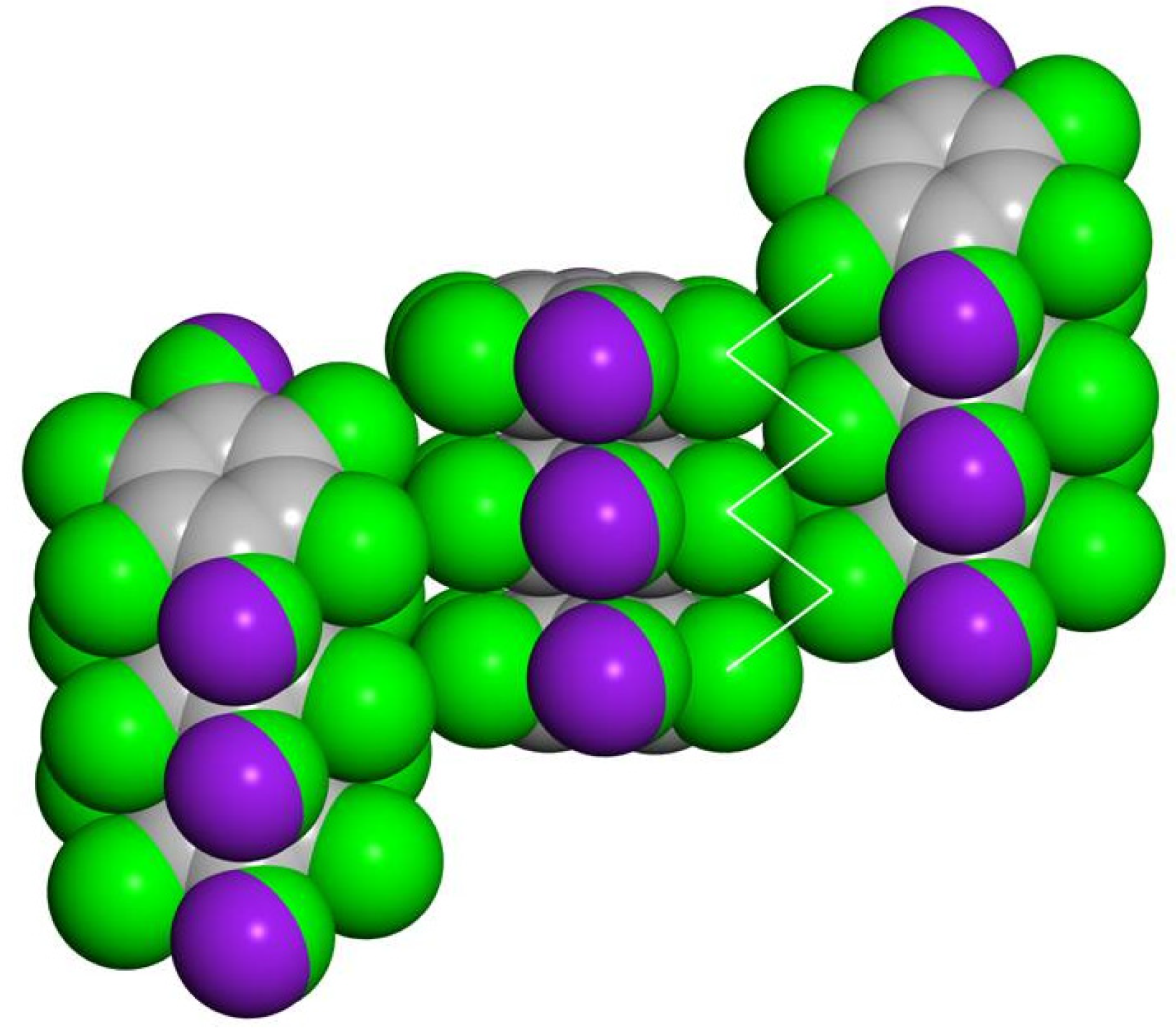Influence of Secondary Interactions on Structural Diversity between a Pair of Halogen-Bonded Co-Crystals Containing Isosteric Donors
Abstract
:1. Introduction
2. Materials and Methods
2.1. Materials
2.2. Formation of (C6I2Cl4)·(4,4-BP)
2.3. Formation of (C6ICl5)·(4,4-BP)
2.4. Single-Crystal X-ray Diffraction
2.5. Computational Methods
3. Results
3.1. X-ray Crystal Structure of (C6I2Cl4)·(4,4-BP)
3.2. X-ray Crystal Structure of (C6ICl5)·(4,4-BP)
3.3. Halogen Bond Energies Using Density Functional Theory Calculations
4. Conclusions
Author Contributions
Funding
Data Availability Statement
Acknowledgments
Conflicts of Interest
References
- Varadwaj, P.R.; Varadwaj, A.; Marques, H.M. Halogen Bonding: A Halogen-Centered Noncovalent Interaction Yet to Be Understood. Inorganics 2019, 7, 40. [Google Scholar] [CrossRef] [Green Version]
- Cavallo, G.; Metrangolo, P.; Milani, R.; Pilati, T.; Priimagi, A.; Resnati, G.; Terraneo, G. The Halogen Bond. Chem. Rev. 2016, 116, 2478–2601. [Google Scholar] [CrossRef] [PubMed] [Green Version]
- Gilday, L.C.; Robinson, S.W.; Barendt, T.A.; Langton, M.J.; Mullaney, B.R.; Beer, P.D. Halogen Bonding in Supramolecular Chemistry. Chem. Rev. 2015, 115, 7118–7195. [Google Scholar] [CrossRef] [PubMed]
- Robidas, R.; Reinhard, D.L.; Legault, C.Y.; Huber, S.M. Iodine(III)-Based Halogen Bond Donors: Properties and Applications. Chem. Rec. 2021, 21, 1912–1927. [Google Scholar] [CrossRef] [PubMed]
- Clark, T.; Hennemann, M.; Murray, J.S.; Politzer, P. Halogen bonding: The σ-hole. J. Mol. Model 2007, 13, 291–296. [Google Scholar] [CrossRef]
- Politzer, P.; Murray, J.S.; Clark, T.; Resnati, G. The σ-hole revisited. Phys. Chem. Chem. Phys. 2017, 19, 32166–32178. [Google Scholar] [CrossRef]
- Awwadi, F.F.; Taher, D.; Kailani, M.H.; Alwahsh, M.I.; Odeh, F.; Rüffer, T.; Schaarschmidt, D.; Lang, H. Halogen Bonding Interactions in Halopyridine–Iodine Monochloride Complexes. Cryst. Growth Des. 2020, 20, 543–551. [Google Scholar] [CrossRef]
- Robinson, S.W.; Mustoe, C.L.; White, N.G.; Brown, A.; Thompson, A.L.; Kennepohl, P.; Beer, P.D. Evidence for Halogen Bond Covalency in Acyclic and Interlocked Halogen-Bonding Receptor Anion Recognition. J. Am. Chem. Soc. 2015, 137, 499–507. [Google Scholar] [CrossRef]
- Varadwaj, A.; Varadwaj, P.R.; Marques, H.M.; Yamashita, K. A DFT assessment of some physical properties of iodine-centered halogen bonding and other non-covalent interactions in some experimentally reported crystal geometries. Phys. Chem. Chem. Phys. 2018, 20, 15316–15329. [Google Scholar] [CrossRef]
- Mandal, S.; Pal, A.K.; Mandal, N.; Mukhopadhyay, T.K.; Datta, A. Harnessing Noncovalent Interactions for a Directed Evolution of a Six-Component Molecular Crystal. J. Phys. Chem. B 2021, 125, 12584–12591. [Google Scholar] [CrossRef]
- Martí-Rujas, J.; Kariuki, B.M.; Hughes, C.E.; Morte-Ródenas, A.; Guo, F.; Glavcheva-Laleva, Z.; Taştemür, K.; Ooi, L.; Yeo, L.; Harris, K.D.M. Structural diversity, but no polymorphism, in a homologous family of co-crystals of urea and α,ω-dihydroxyalkanes. New J. Chem. 2011, 35, 1515–1521. [Google Scholar] [CrossRef]
- Alhalaweh, A.; George, S.; Boström, D.; Velaga, S.P. 1:1 and 2:1 Urea-Succinic Acid Cocrystals: Structural Diversity, Solution Chemistry and Thermodynamic Stability. Cryst. Growth Des. 2010, 10, 4847–4855. [Google Scholar] [CrossRef]
- Yelgaonkar, S.P.; Kiani, D.; Baltrusaitis, J.; MacGillivray, L.R. Superstructural diversity in salt-cocrystals: Higher-order hydrogen-bonded assemblies formed using U-shaped dications and with assistance of π−π stacking. Chem. Commun. 2020, 56, 6708–6710. [Google Scholar] [CrossRef] [PubMed]
- Hasija, A.; Hasija, A.; Chopra, D. Utilizing Co-Crystallization as a Tool to Unravel the Structural Diversity and Electronic Features of I···S Halogen Bonded Interactions in Stoichiomorphic Co-Crystals. Cryst. Growth Des. 2020, 20, 6272–6282. [Google Scholar] [CrossRef]
- Bosch, E.; Ferrence, G.M.; Powell, C.J.; Unruh, D.K.; Krueger, H.R.; Groeneman, R.H. Cooperative non-covalent interactions and synthetic feed as driving forces to structural diversity within organic co-crystals containing isosteric perhalobenzenes. CrystEngComm 2022, 24, 3841–3845. [Google Scholar] [CrossRef]
- Kruse, S.J.; Bosch, E.; Brown, F.; Groeneman, R.H. Incorporating Ester Functionality within a Solid-State [2 + 2] Cycloaddition Reaction Based Upon Halogen Bonding Interactions. Cryst. Growth Des. 2020, 20, 1969–1974. [Google Scholar] [CrossRef]
- Sinnwell, M.A.; Santana, C.L.; Bosch, E.; MacGillivray, L.R.; Groeneman, R.H. Application of a tetrapyrimidyl cyclobutane synthesized in the organic solid state: A halogen-bonded supramolecular ladder. CrystEngComm 2020, 22, 6780–6782. [Google Scholar] [CrossRef]
- Bosch, E.; Kruse, S.J.; Reinheimer, E.W.; Rath, N.P.; Groeneman, R.H. Regioselective [2 + 2] cycloaddition reaction within a pair of polymorphic co-crystals based upon halogen bonding interactions. CrystEngComm 2019, 21, 6671–6675. [Google Scholar] [CrossRef]
- Bosch, E.; Kruse, S.J.; Krueger, H.R.; Groeneman, R.H. Role of π−π Stacking and Halogen Bonding by 1,4-Diiodoperchlorobenzene to Organize the Solid State To Achieve a [2 + 2] Cycloaddition Reaction. Cryst. Growth Des. 2019, 19, 3092–3096. [Google Scholar] [CrossRef]
- Shapiro, N.M.; Bosch, E.; Unruh, D.K.; Krueger, H.R.; Groeneman, R.H. Iodoperchlorobenzene acts as a dual halogen-bond donor to template a [2 + 2] cycloaddition reaction within an organic co-crystal. CrystEngComm 2021, 23, 8265–8268. [Google Scholar] [CrossRef]
- Reddy, C.M.; Kirchner, M.T.; Gundakaram, R.C.; Padmannabhan, K.A.; Desiraju, G.R. Isostructurality, Polymorphism and Mechanical Properties of Some Hexahalogenated Benzenes: The Nature of Halogen···Halogen Interactions. Chem. Eur. J. 2006, 12, 2222–2234. [Google Scholar] [CrossRef] [PubMed]
- Do, H.-Q.; Dauglis, O. A simple base-mediated halogenation of acidic sp2 C-H bonds under noncryogenic conditions. Org. Lett. 2009, 11, 421–423. [Google Scholar] [CrossRef] [PubMed] [Green Version]
- Sheldrick, G.M. SHELXT—Integrated space-group and crystal-structure determination. Acta Crystallogr. 2015, A71, 3–8. [Google Scholar] [CrossRef] [Green Version]
- Sheldrick, G.M. Crystal structure refinement with SHELXL. Acta Crystallogr. 2015, C71, 3–8. [Google Scholar]
- Dolomanov, O.V.; Bourhis, L.J.; Gildea, R.J.; Howard, J.A.K.; Puschmann, H. OLEX2: A complete structure solution, refinement and analysis program. J. Appl. Cryst. 2009, 42, 339–341. [Google Scholar] [CrossRef]
- Frisch, M.J.; Trucks, G.W.; Schlegel, H.B.; Scuseria, G.E.; Robb, M.A.; Cheeseman, J.R.; Scalmani, G.; Barone, V.; Petersson, G.A.; Nakatsuji, H.; et al. Gaussian 16, Revision C.01.; Gaussian, Inc.: Wallingford, CT, USA, 2016. [Google Scholar]
- Pritchard, B.P.; Altarawy, D.; Didier, B.; Gibson, T.D.; Windus. T.L. A New Basis Set Exchange: An Open, Up-to-date Resource for the Molecular Sciences Community. J. Chem. Inf. Model. 2019, 59, 4814–4820. [Google Scholar] [CrossRef]
- Murray, J.S.; Resnati, G.; Politzer, P. Close contacts and noncovalent interactions in crystals. Faraday Discuss. 2017, 203, 113–130. [Google Scholar] [CrossRef]
- Mukherjee, A.; Tothadi, S.; Desiraju, G.R. Halogen Bonds in Crystal Engineering: Like Hydrogen Bonds yet Different. Acc. Chem. Res. 2014, 47, 2514–2524. [Google Scholar] [CrossRef]
- Bosch, E.; Barnes, C.L. Triangular halogen−halogen−halogen interactions as a cohesive force in the structures of trihalomesitylenes. Cryst. Growth Des. 2002, 4, 299–302. [Google Scholar] [CrossRef]







| Co-Crystal | (C6I2Cl4)·(4,4-BP) | (C6ICl5)·(4,4-BP) |
|---|---|---|
| Formula | C16H8Cl4I2N2 | C16H8Cl5IN2 |
| Formula Mass (g·mol−1) | 623.84 | 532.39 |
| Crystal system | triclinic | monoclinic |
| Space group | Pī | P21/n |
| a (Å) | 4.0843(1) | 14.3260(3) |
| b (Å) | 9.4089(2) | 3.8878(1) |
| c (Å) | 12.8307(2) | 17.0394(4) |
| α (°) | 68.543(2) | 90 |
| β (°) | 84.458(2) | 113.747(3) |
| γ (°) | 87.780(2) | 90 |
| Z | 1 | 2 |
| V (Å3) | 456.747(18) | 868.68(4) |
| ρcalcd (g·cm−3) | 2.268 | 2.035 |
| T (K) | 100 | 100 |
| μ (mm−1) | 32.436 | 21.570 |
| F(000) | 292.0 | 512.0 |
| Radiation source | Cu Kα | Cu Kα |
| Reflections collected | 8062 | 6948 |
| Independent reflections | 1800 | 1617 |
| Data/restraints/parameters | 1800/0/110 | 1617/204/151 |
| Rint | 0.0588 | 0.0573 |
| R1 (I ≥ 2σ(I)) | 0.0320 | 0.0673 |
| wR (F2) (I ≥ 2σ(I)) | 0.0840 | 0.1877 |
| R1 (all data) | 0.0326 | 0.0686 |
| wR (F2) (all data) | 0.0844 | 0.1895 |
| Goodness-of-net on F2 | 1.080 | 1.074 |
| CCDC deposition number | 2,204,844 | 2,204,845 |
Publisher’s Note: MDPI stays neutral with regard to jurisdictional claims in published maps and institutional affiliations. |
© 2022 by the authors. Licensee MDPI, Basel, Switzerland. This article is an open access article distributed under the terms and conditions of the Creative Commons Attribution (CC BY) license (https://creativecommons.org/licenses/by/4.0/).
Share and Cite
Krueger, H.R., Jr.; Shapiro, N.M.; Bosch, E.; Unruh, D.K.; Groeneman, R.H. Influence of Secondary Interactions on Structural Diversity between a Pair of Halogen-Bonded Co-Crystals Containing Isosteric Donors. Compounds 2022, 2, 285-292. https://doi.org/10.3390/compounds2040023
Krueger HR Jr., Shapiro NM, Bosch E, Unruh DK, Groeneman RH. Influence of Secondary Interactions on Structural Diversity between a Pair of Halogen-Bonded Co-Crystals Containing Isosteric Donors. Compounds. 2022; 2(4):285-292. https://doi.org/10.3390/compounds2040023
Chicago/Turabian StyleKrueger, Herman R., Jr., Nicole M. Shapiro, Eric Bosch, Daniel K. Unruh, and Ryan H. Groeneman. 2022. "Influence of Secondary Interactions on Structural Diversity between a Pair of Halogen-Bonded Co-Crystals Containing Isosteric Donors" Compounds 2, no. 4: 285-292. https://doi.org/10.3390/compounds2040023
APA StyleKrueger, H. R., Jr., Shapiro, N. M., Bosch, E., Unruh, D. K., & Groeneman, R. H. (2022). Influence of Secondary Interactions on Structural Diversity between a Pair of Halogen-Bonded Co-Crystals Containing Isosteric Donors. Compounds, 2(4), 285-292. https://doi.org/10.3390/compounds2040023






